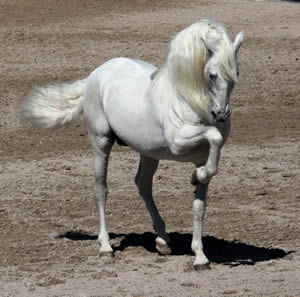History
The Andalusian originated in and gained its name from the Spanish province of Andalusia. Its ancestors are the Iberian horses of Spain and Portugal. Less than 60 years ago, the distinction was made between an Andalusian and a Lusitano horse. The Spanish now refer to their horses as Pura Raza Espanola (Pure Andalusian or PRE) and keep their own studbook. In much of the world, this horse is now referred to as the Andalusian. The Portuguese horse is called Lusitano, taking its name from the ancient Roman name for Portugal, Lusitania.
The roots of the Andalusian reach back to prehistoric times. Cave paintings of horses have been discovered on the Iberian Peninsula in southern Spain dating to 20,000 to 30,000 BC. These prehistoric horses are considered the foundation of the Andalusian. Most experts agree that the breed was sculpted over the centuries by the various people and cultures who occupied Spain throughout its long history. Throughout the centuries, the Iberian horse has been influenced by the horses brought to the Iberian Peninsula by various groups like the Celts of France, the Carthaginians from North Africa, the Romans, various Germanic tribes and the Moors.
By the 15th century, the Andalusian itself began to influence various other breeds. Renowned as one of the world's premier war horses, the ancestors of today's Andalusian played prominent roles in the service of some of history's greatest warriors.
Some researchers believe that the Iberian horse was being ridden perhaps as early as 4,000 - 3,000 BC. When the Phoenicians arrived in Iberia in 2,000 BC and the Greeks in 1,000 BC, the Iberian cavalry was already a formidable foe, and the Iberian horse was regarded as the war horse without equal. Homer mentions the Iberian horses in the Iliad, written about 1,100 BC. The famous Greek cavalry officer, Xenophon, highly praised the "gifted Iberian horses" and their role in helping Sparta defeat the Athenians around 450 BC. Hannibal, in the Second Punic War (218-201 BC), defeated the invading Romans several times through the use of the Iberian cavalry. This military use of the Iberian horse continued unabated with William the Conqueror ultimately riding an Iberian horse in the Battle of Hastings in 1066. While hailed as "the premier war horse," the Iberian horse was also well known for its trusting and kind disposition.
When heavily armored knights began to constitute the majority of the armed forces of Europe the Andalusian was briefly displaced as the most popular war horse. However, after the introduction of firearms, the Iberian horse once again became the mount of choice for royalty and cavalry officers. New means of riding were introduced, often drawn from the writings of Xenophon. The Iberian horse was the favorite horse of the new, rapid and agile mounted armies.
Soon thereafter, the Iberian horse became the "royal horse of Europe" present at every royal court. Grand riding academies were formed in countries all across Europe including Austria, France, Italy and Germany. It was in these academies where dressage and high school riding began and flourished. The Iberian horse was the favored mount of these academies because of its impulsion, forward motion and catlike agility. The Duke of Newcastle, in 1667, wrote of the Andalusian, "it is the noblest horse in the world, the most beautiful that can be. He is of great spirit and of great courage and docile; hath the proudest trot and the best action in his trot, the loftiest gallop, and is the lovingest and gentlest horse, and fittest of all for a king in his day of triumph." It was the Andalusian that served as the foundation for the Lipizzaner of the famed Spanish Riding School in Vienna. It also played a role in the development of most of the German warmbloods, Ireland's Connemara and England's Cleveland Bay, as well as many breeds developed in the New World like the American Quarter Horse and Peruvian Paso.
Today, the Andalusian horse displays an amazing versatility that has, in fact, been present for centuries. The Andalusian's age old attributes of strength, athleticism, impulsion and kind temperament are still the fundamental characteristics of the breed. In the United States, the Andalusian horse competes in dressage, jumping, driving - both pleasure and competitive, trail, western pleasure and English pleasure. In addition, it is a parade and exhibition horse without peer. Of course, we cannot forget that the Andalusian, with its love of people, is an absolutely wonderful family horse. In Spain and Portugal, the Iberian horse displays the ultimate courage, agility, collection and cunning as it faces the fierce Iberian bull, both in and out of the bull-fighting arena. But wherever the Andalusian is found and whatever the Andalusian does, it displays the proud, docile temperament for which it has been prized for millennia.






